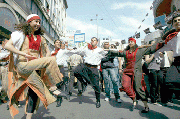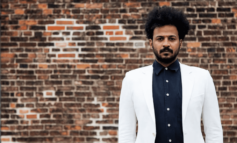
TUSCON — Hani Ghaziz has a loud stomp. The dabke instructor stomps his feet forcefully on the ground, kicks his heels forward and pushes them back down on the floor, making the smooth, wooden floorboards shout. He sashays gracefully forward and tip-toes in place, balancing on his left foot while circling his right leg forward.
“This is called ghazzal,” he said, enunciating the Arabic word for deer to the students attending his public workshop at the Armory Park Senior Centor, 220 S. 5th Avenue, in Tucson, Arizona on Sunday. His trip to teach the dabke was sponsored by the Tuscon chapter of the American-Arab Anti-Discrimination Committee and The Tucson Cultural Exchange Council.
“I can’t do it like that, the way he switches from big stomps to little gallops,” says one of the attendees.
Ghaziz’s ability to quickly transition is also a motif in his daily life, as he switches from dabka instructor to serious student to a New York step dancer.

Ghaziz joined the youth step group, H.A.V.I.C SQUARED, when he moved to New York for college three years ago.
“It was love at first sight,” Ghaziz said. “I’m doing something non-traditional with step, and so I love when non-Palestinians or non-Arabs become interested in dabke.”
At 23, Ghaziz is more poised and worldly than many college students; in addition to the public workshops, he spent his spring break in Tucson, training Al-Haneen, the local dabke group.
Born and raised in Frankfurt, Germany, Ghaziz moved with his family to Ramallah at age 7, where he began dancing dabke with the Sarriyyat Ramallah Troup for Music and Dance.

“It was a for-profit, semi-professional dance group,” he said. “We competed internationally and that’s when I met Bonnie.”
Bonnie Toland, an American who lived in Ramallah for six months in 1999, and who is the founding member of Al Haneen, said Ghaziz was “the perfect person to train the group.”
Toland met Ghaziz when she joined the Ramallah troupe during her trip abroad.
“I was the newest girl and he was the newest guy and so we helped each other out,” she said.
Before moving to Tucson in 2002, Toland headed Zaitoun, a dabke group in Boston, and invited Ghaziz to train its members.
“When he trained them, I wasn’t in Boston, but Zaitoun was really impressed with him, so I knew he could train a large group,” she said, adding that his patience doesn’t hinder his spontaneity when choreographing dances.
Tera Cupis, 21, a student at the University of Arizona, said she was impressed with Ghaziz’s teaching style.
“At first I couldn’t get all of the jumping and kicking, but he breaks it down really well,” she said, wiping the sweat from her brow. “It’s also a really good workout.”
At 77, Bill Faust had no problem keeping up with Ghaziz.

Faust is a member of the Tucson International Folk Dance Club and said many of the dabke moves are similar to traditional folk dancing in other countries, such as Turkey and Scotland.
“I can’t do the squats because I’m too old,” he said. “But it’s not too challenging because I’m used to this sort of dance.”
Folk Dancer Nancy Bannister, 53, said she thinks it’s important to keep the Palestinian tradition of dancing dabke alive, but doesn’t necessarily connect dabke to Palestine.
“I associate dabke with the entire Middle East,” she said, adding that it is also similar to Israeli dance.
Ghaziz said dabke’s international appeal mirrors its artistic caliber.
“It just doesn’t get old, you know. It’s an up-beat form of expression that never dies,” he said.
Ghaziz is as serious about school as he is about dance. He’s studying biomedical engineering at The City College of New York.
“I come from a traditional Middle Eastern family, where the most commendable fields of study are medicine and engineering, so the idea of pursuing art as a career was never in my plans,” he said, while adjusting his kuffiyah. The black and white patterned cloth is the most popular revolutionary activism garb sported at college campuses and public rallies since the Che Guevara t-shirt.
I ask Gaziz if he thinks the significance of dabke will fade over time, and become just another dance.
Thinking, he moves his kuffiyah around his waist and crosses it around his chest into the shape of an X, fastening it around his back.
“Dabke is more than art…dabke is part of the struggle,” he said, still appearing lost in thought.
He doesn’t seem to notice the impact of his statement — especially as his kuffiyah now resembles the shape of a suicide bomber’s vest.
He turned to the group and said, “What do you think, should the guys wear them this way?”
I am not as bold to point out what one Al-Haneen member does:
“Are we gonna dance or blow people up,?” chides Tarik Al Azouzi, a Beirut-born Moroccan from Tucson. “No man, let’s wear them around the neck, it looks better this way.”
The group walks on stage at the Arabian Oasis Cultural Center, 245 W. Speedway, to perform the introductory dance to “Wain A’ Ramallah,” the Palestinian dabke anthem.
“Are they all Arab?” asks one Iraqi woman in the crowd.

The row of dancers responds by splitting in half on opposite sides of the stage for their performance of Dala’ona, a traditional Lebanese dabke song about reuniting with lost love. Their synchronized belbel, inzel, and shemel are Ramallah terms for the dance steps Ghaziz went over in his workshop — but the harmony displayed in each step is universally recognized. Gracefully, like the ghazzal, Ghaziz cues the group for the last sequence, and they half-turn and jump to center, finishing with a taxi-khalus. A series of four heel kicks and a drawn out right-extension-leg stomp sends a bottom-up vibration to the extended row of arms in the air.
In dabke it doesn’t matter.






Leave a Reply